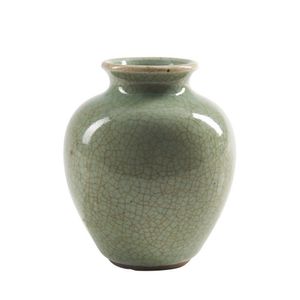Qianlong Celadon Vase with Golden Crackle Glaze
You must be a subscriber, and be logged in to view price and dealer details.
Subscribe Now to view actual auction price for this item
When you subscribe, you have the option of setting the currency in which to display prices to $Au, $US, $NZ or Stg.
- Everted - An everted rim is an outwardly turning or flaring outwards rim, as seen the rims on jugs, vases, bowls and dishes.
- Crackling and Crackle as a Decorative Technique - Crackle, also known as crackling, is a decorative technique that has been used in China for centuries. It is believed to have originated during the Song Dynasty (960?1279 AD) and was primarily used in the production of ceramics, lacquerware, and furniture. The crackling effect was achieved by applying a glaze or lacquer that was formulated to crack during firing, creating a crackled pattern on the surface of the item.
During the Ming Dynasty (1368?1644 AD), crackle became a highly sought-after decorative technique, and it was used to create intricate and beautiful designs on ceramics and lacquer ware.
In Western decorative arts, crackle / crackling came into use during the Art Nouveau movement in the late 19th and early 20th century. The crackling effect was used to create a sense of movement and fluidity in the design of Art Nouveau pieces.
It was also used in the 1920s and 1930s during the Art Deco movement. - Oviform /ovoid - The outline loosely resembling the shape of an egg.
- Crackles / Cracquelure - In ceramics, crackles may be introduced intentionally during the firing process, as was often the case with Oriental ceramics, and are known as artificial crackles. Natural crackles occur with age, and if the glaze is transparent, may be difficult to detect. Natural crackles may not cover the whole surface of the object and may be uneven in size.
This item has been included into following indexes:
Visually similar items

A yellow-glazed vase seal mark of Daoguang the ovoid body standing on a short straight foot and surmounted by a short waisted neck with lipped rim, covered overall with an egg-yolk yellow glaze of even tone, the base engraved with a six-character seal mark

Barry Brickell, large and impressive fatso stoneware jug, green/brown ash glaze with strap handle, impressed potter's cipher to the base of the handle, 1970s, height 37 cm. Provenance: Anneke Borren Collection

A vintage Barry Brickell 'Fatso' jug, pale golden khakhi green salt glaze, heavier towards the top rim, typical sculpted stylised face to the top rim, strap handle, darker firing marks towards the base, impressed potter's mark at base of handle. Height 27

Charles Holmes, lidded salt glazed pot, potter's marks to base. Height 30 cm
